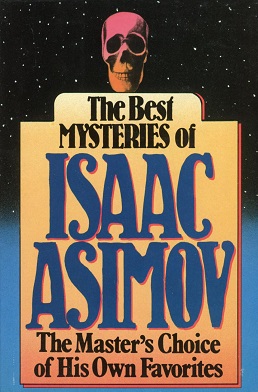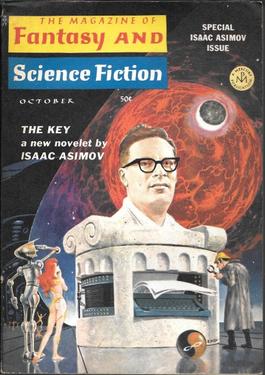Related Research Articles

Isaac Asimov was an American writer and professor of biochemistry at Boston University. During his lifetime, Asimov was considered one of the "Big Three" science fiction writers, along with Robert A. Heinlein and Arthur C. Clarke. A prolific writer, he wrote or edited more than 500 books. He also wrote an estimated 90,000 letters and postcards. Best known for his hard science fiction, Asimov also wrote mysteries and fantasy, as well as popular science and other non-fiction.

A sonnet is a poetic form that originated in the poetry composed at the Court of the Holy Roman Emperor Frederick II in the Sicilian city of Palermo. The 13th-century poet and notary Giacomo da Lentini is credited with the sonnet's invention, and the Sicilian School of poets who surrounded him then spread the form to the mainland. The earliest sonnets, however, no longer survive in the original Sicilian language, but only after being translated into Tuscan dialect.

William Wordsworth was an English Romantic poet who, with Samuel Taylor Coleridge, helped to launch the Romantic Age in English literature with their joint publication Lyrical Ballads (1798).
This is a bibliography of the books written or edited by Isaac Asimov, arranged alphabetically. Asimov was a prolific author, and he engaged in many collaborations with other authors. This list may not yet be complete. The total number of books listed here is over 500. Asimov died in 1992 at age 72; a small number of his books were published posthumously.
The Black Widowers is a fictional men-only dining club created by Isaac Asimov for a series of sixty-six mystery stories that he started writing in 1971. Most of the stories were first published in Ellery Queen's Mystery Magazine, though a few first appeared in Fantasy & Science Fiction, Isaac Asimov's Science Fiction Magazine, and the various book collections into which the stories were eventually gathered.

Murder at the ABA (1976) is a mystery novel by American writer Isaac Asimov, following the adventures of a writer and amateur detective named Darius Just, whom Asimov modeled on his friend Harlan Ellison. While attending a convention of the American Booksellers Association, Just discovers the dead body of a friend and protégé. Convinced that the death was due to murder, but unable to convince the police, Just decides to investigate on his own.
The Petrarchan sonnet, also known as the Italian sonnet, is a sonnet named after the Italian poet Francesco Petrarca, although it was not developed by Petrarch himself, but rather by a string of Renaissance poets. Because of the structure of Italian, the rhyme scheme of the Petrarchan sonnet is more easily fulfilled in that language than in English. The original Italian sonnet form consists of a total of fourteen hendecasyllabic lines in two parts, the first part being an octave and the second being a sestet.
Gilbert Cant was a London-born American journalist.
The Trap Door Spiders are a literary, male-only eating, drinking, and arguing society in New York City, with a membership historically composed of notable science fiction personalities. The name is a reference to the reclusive habits of the trapdoor spider, which when it enters its burrow pulls the hatch shut behind it.
Banquets of the Black Widowers is a collection of mystery short stories by American writer Isaac Asimov featuring his fictional club of mystery solvers, the Black Widowers. It was first published in hardcover by Doubleday in September 1984, and in paperback by the Fawcett Crest imprint of Ballantine Books in June 1986. The first British edition was issued by Grafton in August 1986.

The Return of the Black Widowers is a collection of short mystery stories by American writer Isaac Asimov, featuring his fictional club of mystery solvers, the Black Widowers. It was first published in hardcover by Carroll & Graf in December 2003, and in trade paperback by the same publisher in November 2005.

The Best Mysteries of Isaac Asimov is a collection of mystery short stories by American author Isaac Asimov. It was first published in hardcover by Doubleday in 1986, and in paperback by the Fawcett Crest imprint of Ballantine Books in September 1987.
"The Acquisitive Chuckle" is a mystery short story by American writer Isaac Asimov in 1971, first published in the January 1972 issue of Ellery Queen's Mystery Magazine. He originally called it "The Chuckle", but the magazine's title was kept in subsequent uses of the story. It was the first of Asimov's stories about the Black Widowers, an eccentric group of men who met once a month. The story is based loosely upon the Trap Door Spiders, a stag-club of which Asimov was a member.
"Ph as in Phony" is a mystery short story by American writer Isaac Asimov. It was first published in the July 1972 issue of Ellery Queen's Mystery Magazine under the title The Phony Ph.D. The reason for this title change was that the magazine ran a series by Lawrence Treat with similar "_ is for _" titles. When it was republished in Tales of the Black Widowers in 1974, the original title was restored. It is the second published story about the Black Widowers, a gentlemen's club that solves mysteries based loosely upon the Trap Door Spiders, a stag-club of which Asimov was a member. It was reprinted in the collection The Return of the Black Widowers in 2003.
Robert Parry (1540–1612) was a Welsh poet, romancier and translator who published the romance Moderatus and a collection of verse entitled Sinetes Passions, which may have influenced Shakespeare's sonnets.
"The Ultimate Crime" is a short story by Isaac Asimov, dealing with a minor aspect of one of the Sherlock Holmes stories of Sir Arthur Conan Doyle. It is the 24th of Asimov's Black Widowers mystery stories, and it appeared in his anthology More Tales of the Black Widowers, which collects the second dozen stories of the series. It was written specially for that book. It subsequently appeared again in Sherlock Holmes Through Time and Space, an anthology of stories written by different authors and co-edited by Asimov, and Another Round at the Spaceport Bar.

The Key is a science fiction mystery novelette by American writer Isaac Asimov. It is one of the stories featuring the reclusive scientist Wendell Urth. It first appeared in The Magazine of Fantasy & Science Fiction in October 1966, and was reprinted in the anthologies Asimov's Mysteries (1968) and The Best Mysteries of Isaac Asimov (1986).
Truth to Tell is a 1972 short story by Isaac Asimov. It is one of Asimov's series of stories about the Black Widowers, a gentlemen's dining club that meets monthly to solve mysteries and puzzles. It was first published in the October 1972 issue of Ellery Queen's Mystery Magazine under the title "The Man Who Never Told A Lie", and was included in the 1974 collection Tales of the Black Widowers.
Depending on the counting convention used, and including all titles, charts, and edited collections, there may be currently over 500 books in Isaac Asimov's bibliography—as well as his individual short stories, individual essays, and criticism. For his 100th, 200th, and 300th books, Asimov published Opus 100 (1969), Opus 200 (1979), and Opus 300 (1984), celebrating his writing.
Unsolved! The History and Mystery of the World’s Greatest Ciphers from Ancient Egypt to Online Secret Societies is a 2017 book by American mathematician and cryptologist Craig P. Bauer. The book explores the history and challenges of various unsolved ciphers, ranging from ancient scripts to modern codes and puzzles. The book also invites readers to try their hand at cracking the ciphers, offering clues and hints along the way. The book received positive reviews from critics and readers, who praised its engaging style, comprehensive coverage, and intriguing content.
References
- ↑ "Afterword" to "Sixty Million Trillion Combinations"